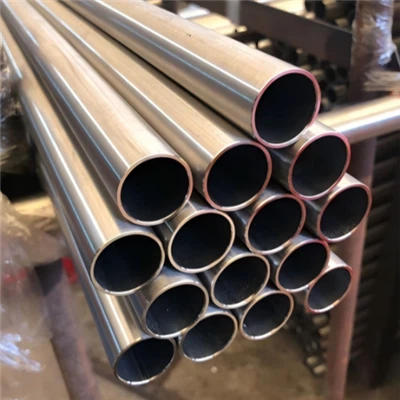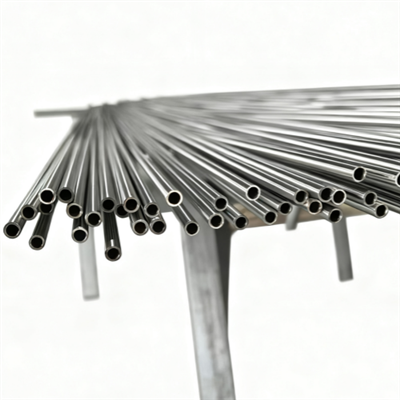Hey there! As an alloy tube supplier, I often get asked about the oxidation resistance of alloy tubes. It's a crucial factor, especially for industries where these tubes are exposed to high temperatures and oxidizing environments. So, let's dive right in and explore what oxidation resistance in alloy tubes really means.
What is Oxidation?
First things first, we need to understand oxidation. Oxidation is a chemical reaction that occurs when a metal reacts with oxygen in the air or other oxidizing agents. When this happens, a layer of metal oxide forms on the surface of the metal. For many metals, this can lead to corrosion, which weakens the metal over time. Think of rust on iron – that's a classic example of oxidation.
In the case of alloy tubes, oxidation can be a big problem. If the tubes are used in high - temperature applications like in power plants, chemical processing, or aerospace, oxidation can cause the tubes to degrade, reducing their lifespan and performance.
How Alloy Tubes Resist Oxidation
Alloy tubes are made by combining different metals to create a material with enhanced properties. One of these properties is oxidation resistance. There are a few ways alloy tubes achieve this:
Formation of a Protective Oxide Layer
Some alloying elements, like chromium, aluminum, and silicon, form a thin, dense, and adherent oxide layer on the surface of the tube when exposed to oxygen. This layer acts as a barrier, preventing further oxygen from reaching the underlying metal. For example, stainless steel alloy tubes, which contain a significant amount of chromium, form a chromium oxide layer. This layer is self - healing, meaning that if it gets damaged, it can reform as long as there is oxygen present.
Alloying with Noble Metals
Noble metals such as platinum, palladium, and gold are highly resistant to oxidation. By adding small amounts of these metals to the alloy, the overall oxidation resistance of the tube can be improved. However, noble metals are expensive, so this method is usually used in high - end applications where cost is less of a concern.
Microstructure Control
The microstructure of an alloy tube also plays a role in its oxidation resistance. A fine - grained microstructure can provide more grain boundaries, which can act as diffusion paths for alloying elements to reach the surface and form the protective oxide layer more quickly. Heat treatment processes can be used to control the microstructure of the alloy tube and enhance its oxidation resistance.
Types of Alloy Tubes and Their Oxidation Resistance
Let's take a look at some common types of alloy tubes and how well they resist oxidation:
Inconel 718 UNS N07718
Inconel 718 UNS N07718 is a nickel - chromium - iron alloy that is known for its excellent oxidation resistance, especially at high temperatures. It contains a significant amount of chromium, which forms a stable chromium oxide layer on the surface. This alloy can withstand temperatures up to about 700°C (1292°F) without significant oxidation. It's widely used in aerospace, gas turbine engines, and nuclear applications.
Monel 400 UNS N04400
Monel 400 UNS N04400 is a nickel - copper alloy. It has good oxidation resistance in both fresh and saltwater environments. The copper in the alloy helps to form a protective copper oxide layer, which provides some protection against oxidation. Monel 400 is commonly used in marine applications, chemical processing, and oil and gas industries.
Incoloy 800, Incoloy 800H, Incoloy 800HT
Incoloy 800 Incoloy 800H Incoloy 800HT are nickel - iron - chromium alloys. These alloys have excellent oxidation resistance at high temperatures due to the presence of chromium and aluminum. They can be used in applications such as heat exchangers, furnace components, and petrochemical processing.
Factors Affecting Oxidation Resistance
The oxidation resistance of alloy tubes is not just determined by their composition. There are several other factors that can affect how well an alloy tube resists oxidation:
Temperature
As the temperature increases, the rate of oxidation generally increases. At higher temperatures, the oxygen atoms have more energy, allowing them to react more readily with the metal. Different alloy tubes have different temperature limits beyond which their oxidation resistance starts to decline rapidly.
Oxygen Partial Pressure
The amount of oxygen in the environment also affects oxidation. Higher oxygen partial pressures mean more oxygen molecules are available to react with the metal, increasing the rate of oxidation. In some applications, the oxygen partial pressure can be controlled to reduce the oxidation rate.
Presence of Contaminants
Contaminants such as sulfur, chlorine, and other halogens can react with the protective oxide layer on the alloy tube, breaking it down and reducing its oxidation resistance. For example, sulfur can react with chromium in the oxide layer to form chromium sulfide, which is less protective than chromium oxide.
Testing Oxidation Resistance
To ensure that alloy tubes meet the required oxidation resistance standards, various testing methods are used:


Thermogravimetric Analysis (TGA)
TGA measures the change in mass of a sample as it is heated in an oxidizing environment. By monitoring the mass gain over time, the rate of oxidation can be determined. This method is useful for studying the oxidation behavior of alloy tubes at different temperatures.
Cyclic Oxidation Testing
In cyclic oxidation testing, the alloy tube sample is repeatedly heated and cooled in an oxidizing environment. This simulates real - world conditions where the tube may experience temperature fluctuations. After a certain number of cycles, the sample is examined for signs of oxidation, such as spalling (flaking off) of the oxide layer.
Why Choose Our Alloy Tubes for Oxidation Resistance
As an alloy tube supplier, we take pride in offering high - quality alloy tubes with excellent oxidation resistance. Our tubes are made from carefully selected alloys, and we use advanced manufacturing processes to ensure consistent quality. We also conduct rigorous testing on all our tubes to make sure they meet or exceed industry standards.
Whether you're in the aerospace, chemical processing, or any other industry that requires oxidation - resistant alloy tubes, we have the right solution for you. Our team of experts can help you choose the best alloy tube for your specific application based on factors such as temperature, environment, and budget.
Let's Talk!
If you're interested in purchasing alloy tubes with great oxidation resistance, we'd love to hear from you. Contact us to discuss your requirements, and we'll work with you to find the perfect solution. We're committed to providing you with the best products and services at competitive prices.
References
-ASM Handbook Volume 13A: Corrosion: Fundamentals, Testing, and Protection.
-Schweitzer, P. A. (Ed.). (2012). Corrosion - Resistant Materials. Marcel Dekker.
-Lipp, W. D. (2010). Oxidation and Corrosion of Metals. Wiley - VCH.






